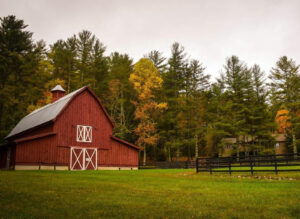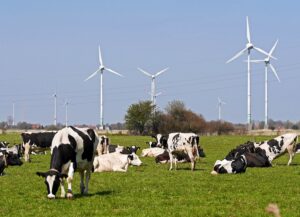Alvaro Garcia
Corn silage constitutes the main forage base in the predominant US dairy production systems. The reasons have been the highly beneficial growing conditions, combined with the energy density contributed to dairy cow diets. Growing corn, however, also demands the right environmental conditions. As a result, some dairy producers also grow alternative forages to use when corn yields are lower than expected particularly in warmer and drier regions of the country.
Aside from sorghum silage, one other alternative that has been explored is pearl millet (Pennisetum glaucum). Because of its origin (Africa), pearl millet is adapted to grow in drier areas of the world, thriving in low fertility soils, and warmer temperatures. It is thus a very good forage “insurance” for warmer areas of the US where environmental conditions may challenge the growth of corn for silage.
Main characteristics of pearl millet as a crop
Pearl millet is a summer crop that adapts well to double cropping and rotations. Other advantages are that its long root system allows the plant to reach deep nutrients in poor sandy soils. It has also fair resistance to pests and does not have the problem of prussic acid toxicity in cattle when its frost stricken. It is recommended to harvest more than once during the season in order to achieve even greater yields than forage sorghum.
There are newer improved varieties of pearl millet that can even yield similar forage tonnage compared to sorghum with just one cut. These new varieties include the brown mid-rib trait (BMR) resulting in higher digestibility when compared to conventional pearl millet varieties. Past research has reported the same production in dairy cows replacing 10% of the corn silage in the diet with pearl millet silage.
A recent experiment (Bernard and Tao, 2020), compared diets based on corn silage and either BMR pearl millet silage or BMR forage sorghum silage to determine dry matter (DM) intake and production performance of mid-lactation Holstein cows. Brown midrib varieties of forage sorghum pearl millet that have the BMR-6 and dwarf genes were planted at the recommended seeding rate of 42 kg/ha.
The forage sorghum was direct chopped at soft dough stage of maturity at a theoretical chop length (TLC) of 1.9 cm and ensiled in a 2.4-m plastic bag. The pearl millet was cut at heading using a disc mower fitted with flails, wilted to approximately 35% DM, chopped at a theoretical chop length of 1.9 cm, and ensiled in a 2.4-m plastic bag. A commercial inoculant was applied in both forages at bagging. Fermentation proceeded for 5 months before feeding to the animals.
Corn was planted at a seeding rate of 70,000 plants/ha using a strip-tillage method and irrigated with dairy waste effluent; fertilizer was applied following soil tests. Corn plants were harvested at three-fourths milk line and chopped to a TLC of also 1.9 cm, with a kernel processor set at 2 mm. It was then inoculated and ensiled in a bunker for 6 months before feeding. Table below shows nutrient composition of forages used in the experiment.
| Nutrient, % of DM | Corn | Pearl millet | Forage sorghum |
| Dry matter | 34.4 | 37.2 | 29.0 |
| Crude protein | 8.4 | 14.2 | 11.7 |
| Ammonia | 1.1 | 3.1 | 1.4 |
| Acid detergent fiber | 24.1 | 35.4 | 38.3 |
| Neutral detergent fiber | 39.3 | 64.6 | 60.5 |
| NDF digestibility after 30 h, % of NDF | 60.5 | 44.0 | 63.6 |
| Ash | 3.36 | 15.9 | 8.26 |
| Ca | 0.25 | 0.75 | 0.59 |
| P | 0.28 | 0.41 | 0.34 |
| pH | 3.75 | 4.88 | 4.37 |
| Total volatile fatty acid | 8.34 | 7.10 | 8.39 |
| Lactic acid | 4.93 | 3.08 | 2.60 |
| Acetic acid | 3.41 | 4.01 | 5.79 |
Productivity in cows feeding pearl millet silage
Holstein cows (139 days in milk (DIM), 37.6 kg/day milk, and 671 kg of body weight (BW)) were individually fed a diet based on 37.2% corn silage and 18.3% ryegrass silage for the first 2 weeks of the experiment. These data were later used as covariate for statistical analysis.
At the end of this period, cows were switched to diets containing 32.6% corn silage plus 20.6% of either BMR forage sorghum silage or BMR pearl millet silage (of the total DM) for the next 6 weeks. Diets containing 53% forage and 47% concentrate were formulated for 100 DIM, 45 kg/day milk with 3.5% fat and 3.0% protein.
The experiment found no differences between treatments in DM intake (26.4 kg/day), milk yield (36.5 kg/day) or milk component concentrations (3.45% fat & 2.78% protein). No differences were also reported in body weight and body condition score between treatments indicating an adequate supply of nutrients both for production and body weight gains.
The results indicated that either pearl millet silage or forage sorghum can be fed with corn silage to mid-lactation without any changes in production performance.
Reference
Bernard, J.K., Tao, S. 2020. Lactating dairy cows fed diets based on corn silage plus either brown midrib forage sorghum or brown midrib pearl millet silage have similar performance. Applied Animal Science. 36(1): 2-7.
© 2020 Dairy Knowledge Center. All Rights Reserved.











